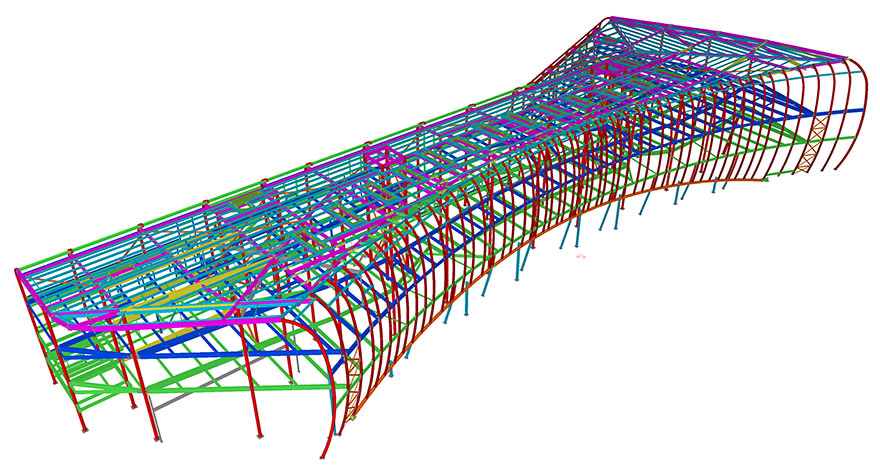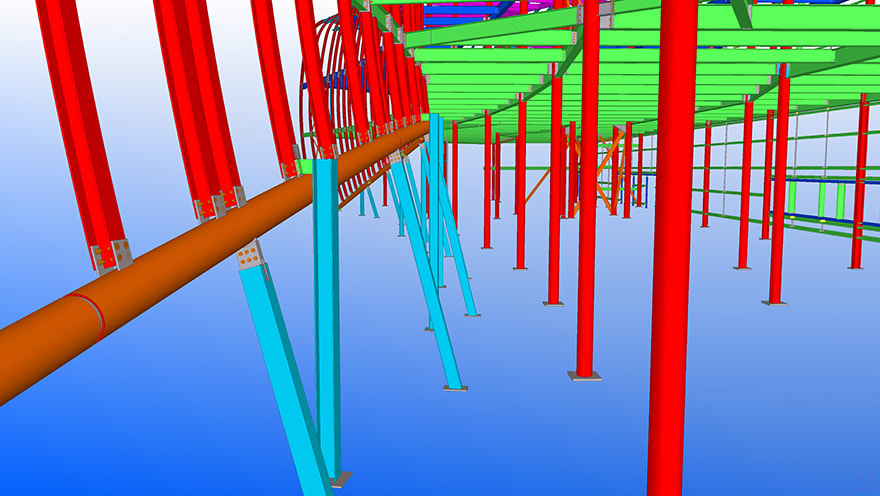- Client: Slough Regeneration Partnership
- Lead Contractor: Morgan Sindall
- BIM Tools: Tekla Structures, Autodesk Revit
The Curve, due to open in spring this year, will be a new state-of-the-art building in the heart of Slough. Work began on the 4,500 sq m facility in early 2014 and once complete, the £22m building will be Slough’s library and cultural centre, including a cafe, museum, performance venue, learning rooms and computer suite. Drawing in residents, visitors and businesses, the Curve will be a modern “meeting place” for the town.
The project is the first phase of a £1bn regeneration for the town by the Slough Regeneration Partnership, a local asset-backed vehicle (LABV) formed by Morgan Sindall Investments and Slough Borough Council. Morgan Sindall is also the contractor for the project, which has been designed by bblur architecture, with Peter Brett Associates as structural and M&E engineer.
The building achieves its looks – and name – through its parabolic curves in plan and elevation. The building is essentially a flared accommodation “tube” with fully glazed entry facades on the east and west which open onto two new public squares, created at each end of the building. These public spaces anchor the building in the heart of the town centre, providing safe external space for use by the building.
The 360 tonne-plus steel-framed building is fabricated in part from tube, with a 323mm diameter tube forming the main supporting member for the curved universal column vertical members. Structural engineer Peter Brett Associates developed the complex steel frame solution, including a V-shaped column created from two 400 x 200 x 16mm elliptical oval hollow sections, which supports a two-storey high Vierendeel truss.

The building achieves its looks – and name – through its parabolic curves in plan and elevation.
Structural steelwork contractor Caunton Engineering was awarded the fabrication contract. According to Robert Berry, director of engineering and innovation at Caunton Engineering, the project provided a perfect opportunity to realise the benefits of a federated BIM design model, although there was no contractual requirement to adopt BIM.
As he explains: “It made a lot of sense for us to work with the architect’s and engineer’s model, but it wasn’t imposed as a requirement. It’s quite typical to be honest, we’re finding there are very few projects where there is a BIM protocol as defined by PAS 1192:2. But designers know what benefits there are to be had, and are almost taking the lead.”
Caunton used Trimble’s Tekla Structures to create its fabrication model, which coped with the the significant challenges created by the building’s challenging geometry and innovative design, and could be integrated with the design team’s Autodesk Revit model.
According to Berry, the company has experienced a wide range of benefits since adopting BIM, from reduced time spent on tenders and more productive design team meetings, to smoother progress on site and significant reduction in remedial works.
“The industry needs better design and BIM can help us deliver it,” says Berry. “Having a BIM model allows our structural engineers to very quickly understand the structure and produce a compliant design in less time. It leads to more accurate and reliable costing of projects, and provides a more thorough understanding which allows us to arrive at the most competitive solution.”

Interfaces between the steel, cladding and curtain walling were complex and critically important
For The Curve, interfaces between the steel, cladding and curtain walling were complex and critically important. So sharing the Tekla Structures model via Tekla BIMsight to the design team facilitated working in a collaborative and constructive way.
Berry says that interoperability between Tekla Structures and Autodesk Revit – using the IFC file format – was generally straightforward. “There’s now a well-defined method of data exchange between Revit and Tekla Structures. There are still some issues of interoperability, but slowly but surely those niggles are being ironed out.”
He added: “It’s opened up more meaningful relationships for us with other specialists. Tekla Structures also creates data in IFC format, which is an essential prerequisite for the open BIM process.”
Since implementing the software, Berry has noticed a big difference in design team meetings: “On projects where BIM is not used, 70% of the time is spent explaining problems and only 30% on agreeing solutions. We have seen almost a reversal of this on BIM projects – 30% of the time is spent reviewing problems that are evident from the model, and 70% spent agreeing solutions collaboratively during the meeting.”
Longer term, Berry believes BIM has the potential to resolve the “blame game” that is too often played on projects. “It is very much a shift from organisation-centric to project-centric decision making. When BIM is adopted, we see far less finger-pointing if something doesn’t work as expected. Now when the question is asked, it is very easy to show that it works in the model, without having to trawl through old drawings and meeting minutes.”
When BIM is adopted, we see far less finger-pointing if something doesn’t work as expected. Now when the question is asked, it is very easy to show that it works in the model, without having to trawl through old drawings and meeting minutes.– Robert Berry, Caunton Engineering











